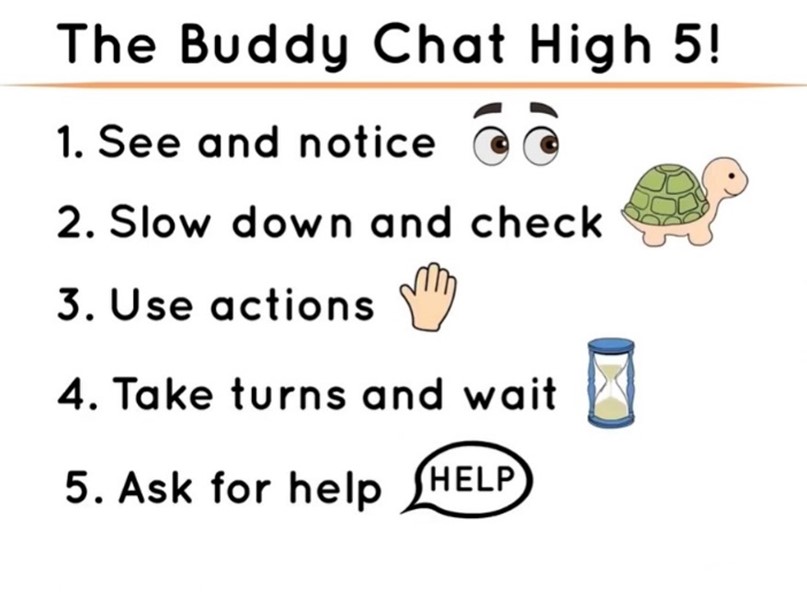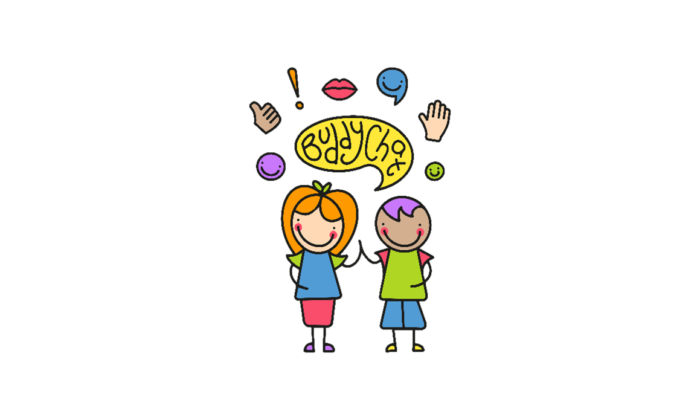Buddy Chat is a new communication project for children, designed to be delivered in classrooms across Northern Ireland.
Further details about Buddy Chat can be found on this page or, if you’re a primary school teacher in Northern Ireland, you can go straight to Buddy Chat to register to take part in the programme.
What is Buddy chat?
Buddy Chat is a free, co-designed children’s communication project designed to raise awareness of speech, language and communication needs (SLCN). Providing insight into the six most common communication differences, the project aims to ensure that children with SLCNs in mainstream settings will be accepted, supported and included by their peers. Buddy Chat is currently available for download by teachers in Northern Ireland. If you are a speech and language therapist or a parent and are interested in learning more, please watch this short video
Educating primary-aged children in understanding and accepting communication differences, as well as equipping them with the tools used in the Buddy Chat High 5 video-based lessons, the project will foster a communication accessible environment at school, in the playground and while out and about, reducing the risk of social isolation and increasing understanding amongst children in this age range.
There are six communication differences that are featured in video- based lessons, with teachers encouraged to select a different topic for each of the two lessons provided:
- Stammer
- Speech Sound Disorder (SDD)
- Developmental Language Disorder (DLD)
- Physical Need (Cleft Palate)
- Deaf
- Autism
Who is Buddy Chat for?
Buddy Chat has been developed for children in mainstream schools, primary 4 and upwards. There are two lessons for each class to complete. Across the two selected lessons, classes will have the opportunity to observe 2 different sets of buddy chat champions and therefore 2 types of communication differences.
Currently Buddy Chat is only available within Northern Ireland.
How does it work?
The Buddy Chat lessons are designed to be played on an interactive whiteboard by the teacher in the classroom. The teacher will need to register with the RCSLT’s learning website to receive a link to download the lessons and accompanying resources. Teachers should register using their @C2Ken.net email address where possible
There are 12 lesson variations across the 6 identified areas of communication difference, with a total of 12 video resources (6 Lesson Ones and 6 Lesson Twos) available. The content of each Lesson One video is identical except for the communication difference represented. Likewise, the information covered in each of the 6 variations of Lesson Two is also identical except for the communication difference represented.
The teacher should select the most appropriate Lesson One and Lesson Two for their class, being aware of individual sensitivities and the pastoral needs of the children. Teachers should choose a different communication difference topic for Lesson Two than they selected from Lesson One, so that children completing a Buddy Chat course have learnt about at least two different communication needs.
Teachers can revisit Buddy Chat later in the year to meet new sets of children talking about a different area of communication needs.
Running a Buddy Chat course
Each class should complete 1x lesson one and 1x lesson two
Lesson One
In Lesson One, the children will learn all about how and why we communicate. They will be introduced to one set of Buddy Chat champions and hear about their communication differences. Lesson one will finish up with the Buddy Chat High 5 song. Each lesson 1 is identical except for the communication difference represented.
Lesson one videos are approximately 20 minutes long. With the addition of teacher prompts and short games, we envisage the lesson to take around 35-40 minutes.
Lesson Two
In Lesson Two, the children recap what they have learned about communication and focus on the Buddy Chat High 5 strategies to help. They will be introduced to another set of Buddy Chat champions and see examples of the High 5 strategies in action. Each lesson two is identical except for the communication difference represented.
Lesson two videos are approximately 15 minutes long. With the addition of teacher prompts, we envisage the lesson to take around 25-30 minutes.
Note – lesson two is designed to be delivered within 1-2 weeks of completing lesson one.
Why take part in Buddy Chat?
The aim is that children with SLCNs in mainstream settings will be accepted, supported and included. Educating the children in understanding and accepting communication differences, as well as equipping them with the tools used in the Buddy Chat High 5 aims to encourage a communication accessible environment at school, in the playground and while out and about, thus reducing the risk of social isolation.
- More than 10% of children have speech, language and communication needs (SLCN). At age five, 7.58% have a language disorder that isn’t linked to another condition, referred to as developmental language disorder.
- A further 2.34% have a language disorder linked to or co-occurring with another biomedical condition, such as autism or hearing impairment (Norbury et al., 2016).
- In addition to this, conditions such as stammering and cleft lip and/or palate also result in speech, language and communication needs.
- In areas of social deprivation, upwards of 50% of children can start school with communication difficulties (Law et al., 2011; Locke et al., 2002).
- SLCN is the third most recorded category on the Special Education Needs (SEN) Register with 11,955 children being recorded in 2022/2023 (DENI, 2023).
- This is an increase of 22% from 2019/2020 (when the SEN and Medical Register were introduced) showing the significant demand for children with SLCN (DENI, 2020)
- Children with SLCN in the preschool, early and primary years are approximately twice as likely to develop social, emotional, and mental health difficulties as children with typical language development when followed up over time (Yew and O’Kearney, 2013).
- People with SLCN are six times more likely to experience clinical levels of anxiety and three times more likely to have clinical depression (Conti-Ramsden and Botting, 2008).
- Children with SLCN experience higher levels of bullying (Dockrell and Howell. 2015)
- Children and young people with SLCN report a poorer quality of life than their peers particularly around their moods and emotions and in terms of social acceptance and bullying (Dockrell et al., 2012).
What is the Buddy Chat High 5?
The Buddy Chat High 5 are strategies to help children when they know someone who finds communication tricky, or who communicates differently to them. We hope to empower children to become kind and caring communicators at school and in their communities.




